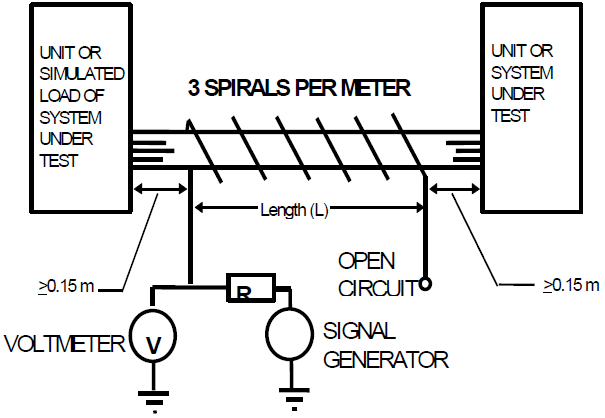
RTCA/DO-160
RTCA/DO-160 Section 19: Induced Signal Susceptibility
Standard Overview
RTCA/DO-160 Section 19 provides test procedures to determine whether the EUT can operate as required when the equipment and interconnecting cables are subjected to audio frequency electric fields, magnetic fields, and transient voltage spikes.
In RTCA/DO-160 Section 19, the test levels for interconnecting cable tests are determined by the length of wire exposed to the radiating wire. RTCA/DO-160 Section 19 states that magnetic and electric fields induced into cables, the test level is defined as the product of the length of interconnecting cable exposed to the radiating wire and the rms voltage or current applied to the wire.

Equipment
RTCA/DO-160 provides standard procedures and environmental test criteria for testing airborne equipment for the entire spectrum of aircraft from light, general aviation aircraft and helicopters through the "jumbo jets" and SST categories of aircraft. The tests outlined in this standard are performed to meet FAA and international regulations for electrical and electronic equipment installed on commercial aircraft.
RTCA/DO-160 G is the current version of this standard. Coordinated with EUROCAE, RTCA/DO-160G and EUROCAE/ED-14G are identically worded. DO-160G is recognized by the International Organization for Standardization (ISO) as de facto international standard ISO-7137.
The Equipment Categories are comprised of two characters. The first character (A, B, C, or Z) indicates the tests performed and severity level of the tests. The second character (C, N, or W) indicates the AC power system operating frequency (Constant, Narrow Variable, or Wide Variable) which the EUT is compatible with.
User Guide
Buy Standard
View DO-160 Sec. 19 Setup
(spikes) calibration setup

(spikes) test setup

In RTCA/DO-160 Section 19, the test levels for interconnecting cable tests are determined by the length of wire exposed to the radiating wire. RTCA/DO-160 Section 19 states that magnetic and electric fields induced into cables, the test level is defined as the product of the length of interconnecting cable exposed to the radiating wire and the rms voltage or current applied to the wire.

Equipment
RTCA/DO-160 provides standard procedures and environmental test criteria for testing airborne equipment for the entire spectrum of aircraft from light, general aviation aircraft and helicopters through the "jumbo jets" and SST categories of aircraft. The tests outlined in this standard are performed to meet FAA and international regulations for electrical and electronic equipment installed on commercial aircraft.
RTCA/DO-160 G is the current version of this standard. Coordinated with EUROCAE, RTCA/DO-160G and EUROCAE/ED-14G are identically worded. DO-160G is recognized by the International Organization for Standardization (ISO) as de facto international standard ISO-7137.
The Equipment Categories are comprised of two characters. The first character (A, B, C, or Z) indicates the tests performed and severity level of the tests. The second character (C, N, or W) indicates the AC power system operating frequency (Constant, Narrow Variable, or Wide Variable) which the EUT is compatible with.
User Guide
Buy Standard
View DO-160 Sec. 19 Setup
(spikes) calibration setup

(spikes) test setup

Products Used in Testing

AE Techron 3110 Standards Waveform Generator
- Includes a large library of Automotive and Aviation Standards’ test routines--complete list available as Supplemental Document under Datasheet on left
- Drag and drop interface makes it easy to modify existing tests or build new waveform sequences
- Loop entire tests or test sections; repeat loops with increments of up to four variables


AE Techron 7228 Linear Power Amplifier
- DC – 1 MHz
- Gain: 20V
- AC Power: 1000W RMS


EMC Partner MIL3000 Military Test System
- Exceeds maximum test levels in MIL-STD-461
- One coupler for tests (CS115 & CS116)
- Test report data stored in MIL3000, accessible via USB or Ethernet


EMC Partner MIL3-DO-160-S19 Plugin for MIL3000 Test System


AE Techron T1000 Magnetic-Field Susceptibility Transformer
- Up to 100ARMS secondary current.
- Exceeds AF Magnetic Field test requirements of DO 160 Section 19 and Boeing D6-16050-5 Section 7.2.2.
- Circuit breaker protected from over-current.


AE Techron T3700 Electric-Field Susceptibility Transformer
- Up to 3,700 volts, 11,000 V/m.
- Meets or exceeds voltage requirements of DO 160 Section 19 and Boeing D6-16050-5 Section 7.2.
- Robust design; withstand tested to 5,000VRMS.


AE Techron 7224 Linear Power Amplifier
- Frequency Range: DC – 300 kHz
- Gain: Voltage Mode: 20 V
- Max Output Power: 1,100 W RMS


AE Techron 8704 Linear Power Amplifier
- Frequency Range: DC – 250 kHz
- Gain: 20V
- Max Power Output: Up to 4 kW continuous


AE Techron 7782 RMS Power Amplifier
- Frequency Range: DC – 50 kHz at full power
- Gain: 20V
- Max Power Output: 3305 W RMS (2 Ω)


AE Techron 7136 AC/DC Amplifier with Precision DC Power Supply
- Frequency Range: DC – 150 kHz
- Gain: 40 V
- Max Power Output: 900 W RMS (AC)


AE Techron 9110 Amplifier
- Frequency Range: DC – 250kHz (–3 dB)
- Gain: 20V
- Max Power Output: 5kW


AE Techron 7796 DC Power Amplifier
- Frequency Range: DC – 50kHz (rated) | DC – 100kHz (reduced)
- Gain: 20V
- Max Power Output: 22,000 W peak (40 mSec, 0.5 Ω load)


AE Techron 7794 4-Quadrant Power Amplifier
- Frequency Range: DC – 150 kHz
- Gain: 20 V
- Max Power Output: 5,000 W RMS (continuous)


AE-Techron 7796HC DC Power Amplifier
- Frequency Range: DC – 150 kHz
- Gain: 20 V
- Max Power Output: 2,499 W RMS continuous


AE Techron 8500 Series Amplifiers | DC to 50 kHz, 60 to 300 ARMS
- Bandwidth: DC to 50 kHz
- Current: 60 to 300 ARMS
- For Mil-PRF capacitor tests, DC automotive dropout testing, and as a variable AC source for ISO 61000, Aviation and Power Quality Measurements.
